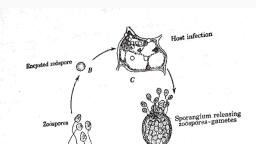Page 3 :
ror cylindrical. The nucleus b P n the region of central v, In Ectocarpus the reproduction, cellulosic layer. The outer ge matophores. The number and s, 6.2 Occurrence of Ectocarpus, Ftocorpus is cosmopoliton in distribution mainly in colder seas and polar regions. Ectocarpus is very, common on sea shore of Atlantic ocean. Ectocarpus is mainly found attached on rocks. Some Ectocarpus, by P, by, are epiphytic, e.g., E.coniferus and E.breviarticulatus are found growing on larger algae like Fucus, and Laminaria, E.dermonematus is endophytic species., on fins of certain fishes. The genus Ectocarpus has about 100, India, e.g., E.arbicus, E.coniferous, E.dermonematus,, is, an epizoic species found, wing, of which 13 species are common in, shant si by Prash, ishant sir, igeminifructus, Thallus Structure, The thallus of Ectocarpus is heterotrichous, differentiated into a, prostrate rhizoidal system and on projecting or erect system., In some species one of the two systems may be reduced. In, epiphytic forms the prostrate system is well developed and the, erect system is reduced. The prostrate system is branched and, creeping on the substratum, its, the sha, is irregularly and, absorption., The erect part of the, branched, branches arise just below the transverse septa of the, cell. The cells are uniseriate, joined end to end in a row, e.g.,, Chromatophore, monosiphonous., A, Fig. 28: A Phaeophycea: Structure of a Cell, 6.3 Cell Structure, The cells ar, e uninucleate and rectangular or, suspended by protoplasmic threads., s. The cell wall is differentiated into outer gelatinous layer and the, cytoplasm which contains, layer is made of algin and, of, different, irregular branches, e.g., E.siliculosus. The, chromatophores are many discoid, e.g., E. granulosus. Each chromatophore has a projected pyrenoid., The chromatophores contain pigments, chlorophyll-a, chlorophyll-c, carotenes and xanthophylls., of chromatophores vary, Xanthophylls are more in amount and fucoxanthin is responsible for its brown colour. Fucosan vesicles or, granules are also present in cytoplasm. The reserve food material is in form of laminarin and mannitol. In, life-cycle of Ectocarpus both haploid and diploid filaments are found which are morphologically similar., diploid filaments have usually longer, ahanse, takes place by asexual and, 6.4, Reproduction, than haploid filaments., 6.4.1 Asexual Reproduction, methods., The asexual reproduction takes place by biflagellate zoospores. The zoospores are formed in unilocular and, plurilocular sporangia. The sporophytic diploid plant forms two types of sporangia : 1. Unilocular sporangia, 2. Plurilocular sporangia. The unilocular zoosporangia form haploid zoospores and plurilocular sporangia form, diploid zoospores. Both types of sporangia may be borne on same plant, Prashant, or on different plants., shant st, chark sir, hant
Page 4 :
"orophytic plants in appearance. On maturity the, Structures is called plurilocular sporangium (Fig. 3, by, by A, Sporangial Nucleus, Tinsel, initial, (2x), Unilocular, flagellum, Nuclei, sporangium, (x), ant sir, Sporangium, Stalk cell, Deflagellated, meiozospore, OPOSO, bnash, E, ant sin, Germ tube, F, G, Prostrate filament, Fig. 29 (A-H): Ectocarpus : Asexual Reproduction: (A-D) Stages in the Development of, Unilocular Sporangia, (E) Meiozoospore, (F-H) Stages in the Germination of Meiozoospore, Carashacin, Unilocular Sporangia, The, in size and becomes, initial divides by transverse division forming a, (Fig. 29B). The nucleus of the sporangial divides by, ellipsoidal. This cell functions as sporangial initial (Fig., terminal cell of the branch gradually, smaller stalk cell and, The, are not followed by wall formation and the, sporangium remains unilocular. Each nucleus of sporangium gets surrounded by a protoplast segment and, divisions,, ultimately transforms into 32-64 zoospores. Each zoospore is pyriform, uninucleate with laterally inserted two, unequal flagella. The anterior flagellum is longer, pantonematic and directed forward while the posterior, flagellum is shorter acronematic (Fig. 29D) and directed backward. The zoospores have chromatophore and, an eye-spot. The zoospore remain inactive for short time and then become free and swim in water., The haploid zoospores germinate within 2-3 hours to form haploid Ectocarpus plants called gametophytic, gametophytic plants bear plurilocular gametangia., Plurilocular Sporangia, Like unilocular sporangia, these sporangia also develop from terminal cells of the branchlets of diploid, sporophytic plants. The terminal cell which functions as sporangial initial enlarges and becomes spherical., This cell accumulates protoplasm and chromatophores. It repeatedly undergoes transverse divisions to form, a row of 5-12 cells (Fig. 30 A-B). Then vertical divisions start in all the cells starting with the median cell of the, row. The repeated transverse and vertical divisions result in formation of about 660 cubical cells arranged n, transverse tiers. This, cell transforms into a single biflagellate zoospore., The, sha, shan, bcashani, brashant sir



























































